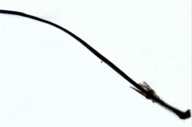Rapp-Hodgkin syndrome
Published Web Location
https://doi.org/10.5070/D34v52k16vMain Content
Rapp-Hodgkin syndrome
Gene Kim MD, and Helen Shin MD
Dermatology Online Journal 10 (3): 23
From the Ronald O. Perelman Department of Dermatology, New York University
Abstract
A 5-year-old boy with a history of a bifid uvula and a submucosal cleft palate presented for evaluation of brittle nails. The physical examination demonstrated cup-shaped ears, a broad nasal root, thin upper lip, mid-facial hypoplasia, coarse hair, and twenty-nail dystrophy. The clinical presentation of ectodermal dysplasia with cleft palate was consistent with Rapp-Hodgkin syndrome, which is one of several allelic diseases associated with mutations in the TP63 gene. The clinical manifestations of Rapp-Hodgkin as well as other ectodermal dysplasias with clefting are discussed.
Clinical synopsis
History.—A 5-year-old boy presented to the Bellevue Hospital Medical Center Pediatric Dermatology Clinic with his mother in March 2003 for evaluation of nail dystrophy that he had had since birth. His mother stated that he was born with a weight that was appropriate for his gestational age after an uncomplicated, full-term, vaginal delivery.
There was no family history of genetic disease or a history of phenytoin use during or preceding the pregnancy. Shortly after birth, he had feeding difficulty with nasal regurgitation and was found to have a bifid uvula, a submucosal cleft palate, facial dysmorphism, coarse hair, and brittle nails. He underwent cleft palate repair at age 1 and required speech and feeding therapy.
Over the past 3 years, he has continued to develop normally physically but has had some speech delay. His mother describes coarse hair and persistently brittle nails. He sweats only around the forehead, but there is no history of heat intolerance, hypospadia, scalp dermatitis, or conjunctivitis.
Physical examination.—Slightly upslanted eyes, cup-shaped ears, high forehead, a broad nasal root, hypodontia, a thin upper lip, and mid-facial hypoplasia were present. His hair appeared to be coarse. His hair-pull test was negative. He had twenty-nail dystrophy, which was characterized by distal onycholysis, thinning, longitudinal ridges, and a pterygium of one nail.

|

|
| Figure 1 | Figure 2 |
|---|

|

|
| Figure 3 | Figure 4 |
|---|
Laboratory data.—Renal ultrasound and a cardiac echocardiogram did not demonstrate any abnormalities. Chromosomal analysis showed a 46-XY karyotype. Periodic-acid-Schif stain and culture of the nail were both negative for fungi.
Histopathology.—Six hair shafts with roots, five of which are in anagen stage and one in telogen stage, are examined. Three hair shafts are of slightly uneven thickness and two of them show subtle longitudinal twisting. There is no evidence of ruffled cuticles. Examination under polarized light shows no evidence of clear and dark bands.
Diagnosis.óRapp-Hodgkin syndrome.
Comment
The ectodermal dysplasias are a heterogeneous group of disorders, which are characterized by developmental defects of ectodermally derived structures that include hair, teeth, nails, and sweat glands. [1] Three inherited disorders with ectodermal dysplasia are associated with cleft palate and include the ectrodactyly-ectodermal dysplasia-cleft lip-palate syndrome (EEC), ankyloblepharon filiforme adenatum-ectodermal dysplasia-cleft palate syndrome (AEC), and Rapp Hodgkin syndrome. These disorders are generally inherited in an autosomally dominant fashion but sporadic mutations do occur. [2]
Classically, Rapp-Hodgkin syndrome can be differentiated from the other two ectodermal dysplasia syndromes with a cleft palate on the basis of key clinical features. EEC syndrome is characterized by ectrodactyly (abnormal development of the median rays of the hands and feet) whereas AEC syndrome generally presents with a collodion-like membrane at birth and ankyloblepharon filiforme adenatum (strands of skin between the eyelids). [3,4]
Individuals with Rapp-Hodgkin syndrome generally have striking faces that include a high forehead, hypoplastic maxilla, low nasal bridge, and a thin upper lip. These features are found in addition to other traits that are common to all three conditions that include hypodontia, brittle hair that may include pili torti or pili trianguli et caniculi, dysplastic nails, mid-facial hypoplasia, hypospadia, lacrimal duct anomalies, and hypohidrosis. [5,6]
Despite the variability of these diseases clinically, recent genetic studies have demonstrated that all three are linked to mutations in the TP63 gene. TP63 is a TP53 homologue that is involved primarily in embryo development. However, unlike TP53, TP63 is rarely mutated in cancer, and patients with defects in TP63 do not show an increased susceptibility to cancer. [7] Differences in the location or type of mutation to TP63 are thought to explain the spectrum of the phenotype expressed. EEC mutations generally affect the TP63 DNA-binding domain whereas AEC and Rapp-Hodgkin syndrome mutations involve the SAM domain. The similarity between the type of mutation observed in AEC syndrome and Rapp-Hodgkin syndrome suggest that these two diseases are actually the same clinical entity. [8]
The treatment of the ectodermal dysplasia syndromes with clefting generally involves supportive care. Treatment of the clefting involves a multidisciplinary approach for repair and follow up of orthodontia, speech defects, feeding problems, and ear infections.
References
1. Trueb RM, et al. Scalp dermatitis, distinctive hair abnormalities, and atopic disease in the ectrodactyly-ectotdermal dysplasia-clefting syndrome. Br J Dermatol 1995; 132: 621.2. Cambiaghi S, et al. Rapp-Hodgkin syndrome and AEC syndrome: are they the same entity? Br J Dermatol 1994; 130: 97.
3. Mallory SB, et al. What syndrome is this? Ectrodactyly, ectodermal dysplasia, and cleft palate (EEC) syndrome. Pediatr Dermatol 1997; 14: 239.
4. Hay RJ, Wells RS. The syndrome of ankyloblepharon, ectodermal defects and cleft lip and palate: an autosomal dominant condition. Br J Dermatol 1976; 94: 277.
5. Camacho F, et al. Rapp-Hodgkin syndrome with pili canaliculi. Pediatr Dermatol 1993; 10: 54.
6. Cliff S, Holden CA. What syndrome is this? Rapp-Hodgkin syndrome. Pediatr Dermatol 1997; 14: 149.
7. Barrow LL, et al. Analysis of the p63 gene in classical EEC syndrome, related syndromes, and non-syndromic orofacial clefts. J Med Genet 2002; 39: 559.
8. Dianzani I, Garelli E, Gustavsson P, Carando A, Gustafsson B, Dahl N, Anneren G. Rapp-Hodgkin and AEC syndromes due to a new frameshift mutation in the TP63 gene. J Med Genet. 2003 Dec;40(12):e133. PubMed
© 2004 Dermatology Online Journal

